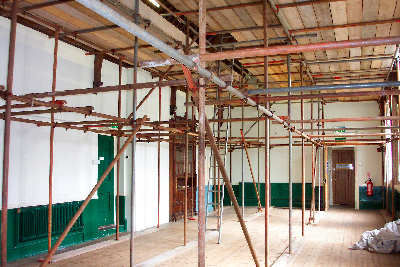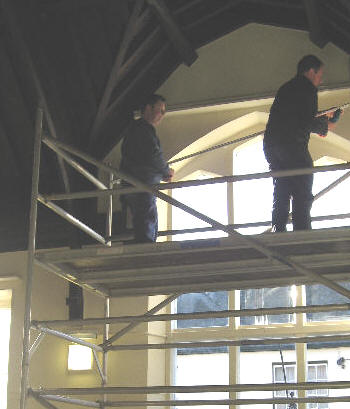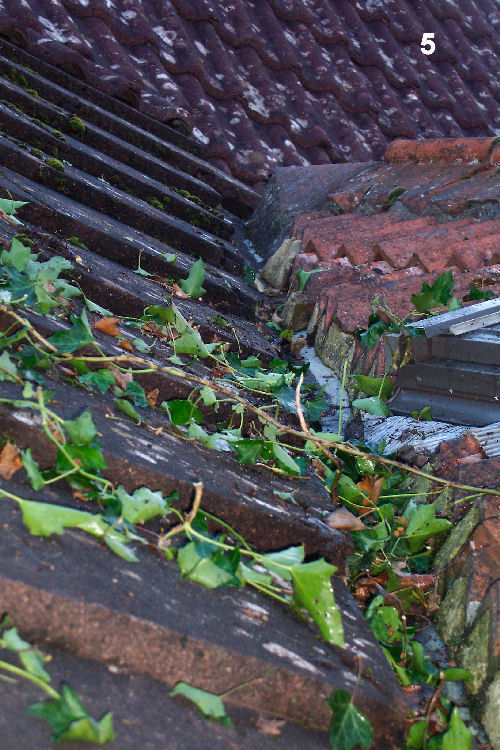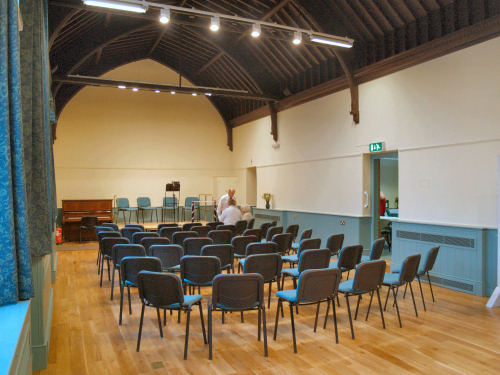Replacement
of floor surface and supporting structure
Failure
of the floor support structure after 120 years threatened the future of
the Jubilee Hall.
Its
repair cost approx £35,000.An essential part of the work involved the improvement
of the ventilation of the floor void and the damp proofing of the cavity
Modern damp proof membranes were also used to further protect the new
‘tanalised’ floor plates and joists. Thermal insulation panels were
also incorporated for the first time to retain Hall heating. Marine
quality plywood sheets were then laid above the joists and insulation to
provide a strong and level surface for the mounting of the high quality
oak flooring strips.
Treatment
of hall ceiling, and repairs to roof of annex

The
beautiful vaulted ceiling helps make the Jubilee Hall very special, but
it is difficult to maintain. It has suffered many attacks by woodworm
over the years, and these if not treated would eventually destroy it. The
work carried out has been aimed at correcting both problems. It was
carried out in the heat of a very hot summer and while our team were
applying chemical dressings, temperatures in the ceiling space reached
over 100 Deg. F. Access was a difficult problem and a complex system of
scaffolding had to be installed, made more difficult by the weak floor
upon which it stood.
It was felt that it had sufficient strength to
hold the scaffolding, and it was important that the renewal of the floor
should be carried towards the end of the project. With
care and proper maintenance the floor surface would last many
years.
Extensive
work was also a carried out to the roof of the rear annex.
Many of the timber roof joists in this area were rotten due to problems
with the roof tiling and flashings, caused to some extent by Ivy
penetrating the roof void. These had to be repaired or replaced, and
lead gulleys and flashings were installed to ensure that there would be
no further backing up of rainwater during heavy downpours.
Renewal
of electrical and heating system.
Although
safe, the major part of the electrical wiring system was at least
twenty-five years old and coming to the end of its life. The lighting
system in the main hall was also old and inadequate by modern standards.
Furthermore the h all had no Public Address system and no
induction loop to help the hard of
hearing. The heating distribution system was
likewise elderly, using cast iron piping and cast iron column radiators
that were difficult to keep clean. Protruding control knobs also
represented a real risk of injury to children playing in the hall. The
new lighting system has been designed specifically, at no cost, by the
lighting distributor to meet our
particular requirements. It provides a highly efficient and flexible
system to meet the many different requirements of our hall users. all had no Public Address system and no
induction loop to help the hard of
hearing. The heating distribution system was
likewise elderly, using cast iron piping and cast iron column radiators
that were difficult to keep clean. Protruding control knobs also
represented a real risk of injury to children playing in the hall. The
new lighting system has been designed specifically, at no cost, by the
lighting distributor to meet our
particular requirements. It provides a highly efficient and flexible
system to meet the many different requirements of our hall users.
The design and installation of
the PA and Induction loop system was designed and installed by a
business based in the parish, and would be of enormous benefit to many
users of the Jubilee Hall. The Hall was also well equipped with power
sockets, including some flush mounted in the floor. Additional power
points were fitted in the roof space to facilitate the extra
lighting associated with drama productions. New lights were also been
fitted in the Committee Room. The heating system has been fitted with
new copper piping, and the radiators replaced by finned coil heat
exchangers, cased within the wainscot for safety and good appearance.
The
general fabric of the hall.

History
of the parish tells us that maintaining the fabric of the hall has been
an ongoing problem from the start of the last century. There is,
however, no record of such a comprehensive range of work being carried
out previously at one time. One of the biggest problem was the renovation of the
cast iron guttering and down pipes. Believed to be the original fittings
they are made of cast iron, in sizes and styles now impossible to buy.
Despite extensive searching we were unable to locate some suitable
replacement items at architectural reclamation yards. As a result these
parts were either handcrafted to match, or repairs were carried out to
the originals. All were stripped of rust and old paint and then prepared
and repainted to the highest standard. It was also decided to replace
some small windows where the wooden frames were rotten. The frosted
glass in the large main windows was also replaced with clear glass, due
to the cracks that had appeared.
About ten years later it was again necessary to replace this window,
with a much higher standard unit.
Another major problem was the ingress
of water into the extension at the rear of the hall where the men's
toilet is located. This resulted in the restructuring of the roof, and a
certain amount of retiling, and the fitting of new lead flashings. Some
twelve years later (2019) more work was required to solve this damp
problem, which involved fitting a waterproof membrane to the party
wall. At
the same time a light tube was fitted to bring natural light into the
lobby area used to access the toilets and for storage.
Areas
of stone and brickwork were in need of re-pointing. The
front face of the Hall had also accumulated a heavy layer of dirt since
it was built, and the front and side walls were pressure washed,
revealing the attractive chequer board, coursed stone work that had long
ago ceased to be visible.
Improvements and
modifications to the interior.
Following on from
the work on the floor and the ceiling, it became apparent that more
improvements were needed and could be carried out at minimum cost. Some
changes were also forced upon us due to the dilapidated condition of the
hall. Sadly, it was necessary to remove the tall cupboard and the hall
separator. The fascia of the former went to auction, and the latter
has been recycled into the panelled wainscot. The extent of the ‘making
good’ after the ceiling, floor, heating g and electrical works also
necessitated the installation of the wainscot and redecoration using a
practical but modern colour scheme. It was also decided to make use of
cupboard space on the upper floor to create a ‘Producers’ window and
studio, complete with wiring that will facilitate, at a later date the
installation of a lighting and sound control panel. This would make drama
productions much easier to manage. All the toilet facilities were
dramatically improved, with a new floor installed in the toilet for the
disabled. In order to comply with the requirements of the Disability
Discrimination Act, portable ramps are now immediately available for
those who need them, and the Hall is now as fully
compliant with the legislation as is possible. g and electrical works also
necessitated the installation of the wainscot and redecoration using a
practical but modern colour scheme. It was also decided to make use of
cupboard space on the upper floor to create a ‘Producers’ window and
studio, complete with wiring that will facilitate, at a later date the
installation of a lighting and sound control panel. This would make drama
productions much easier to manage. All the toilet facilities were
dramatically improved, with a new floor installed in the toilet for the
disabled. In order to comply with the requirements of the Disability
Discrimination Act, portable ramps are now immediately available for
those who need them, and the Hall is now as fully
compliant with the legislation as is possible.
Click HERE to go to the re-Opening
Event
Click
HERE to return to the Renovation Index
Click HERE to return to
Introduction
February 2017
|